Among Spanish-speaking readers, as in the rest of the world, Pride and Prejudice is the most widely known, the most popular, and the most beloved Austen novel. Owing much of that popularity to the 1940 and 2005 cinematographic adaptations, it has never been out of print since 1924, when it was first published in Spanish—111 years after the original publication, and the third Austen novel published in that language. Keeping track of its different editions is almost a Herculean task. Aída Díaz Bild, for example, counted at least seventy editions between 1924 and 2006, and that includes only editions published in Spain.
As I have shown in my essay on Sense and Sensibility, a translation can be printed and reprinted for different editions among different publishing houses. There are also rehashed translations based on previous ones rather than on the original English text. María Nieves Jiménez Carra has traced how these problems occur frequently with editions of Orgullo y Prejuicio, even—as we will see—those from powerful and prestigious publishing houses.1 Furthermore, as Díaz Bild points out, with very few exceptions, most Spanish editions of Pride and Prejudice are issued for mass market consumption (195).
In that endless stream of Orgullo y prejuicio editions, how can we find out which are worthwhile, and which are dispensable? And since most of them come from Spain, are there any editions specifically designed for Latin-American readers or other kinds of reader? By tracing the history of this novel in the Spanish-speaking world, we not only see its unshakable rise to popularity and the trends it has followed (i.e., in covers and illustrations) but perhaps also find some answers to those questions.
This essay is the first of three examining translations of Pride and Prejudice for the Spanish-speaking world. Here I focus on the history of translations initially published before the dawn of Austenmania--although some have been recycled and are still in print in the twenty-first century.
The first translation and its by-products
Although the very first edition of Jane Austen in Spanish was published in 1924, Mari Carmen Romero discovered that the first translation of Pride and Prejudice was presented to the Real Academia de Bellas Letras de Barcelona [Royal Academy of Literature of Barcelona] in 1918 (Historia). How or why it took six years to be published is a mystery. Its first translator was José Jordán de Urríes y Azara (1868–1932), a college professor and member of the Royal Academy, who sprang from a cadet branch of an ancient and aristocratic Spanish family (usually mistakenly confused as a younger brother of the marquis of Ayerbe, head of the main branch). His Orgullo y prejuicio was published by Calpe (acronym of Compañía Anónima de Librería, Publicaciones y Ediciones [Anonymous Company of Bookstore, Publications and Editions]) in two volumes as part of its Colección Universal. Calpe had also published Persuasión (1919) and La abadía de Northanger (1921).
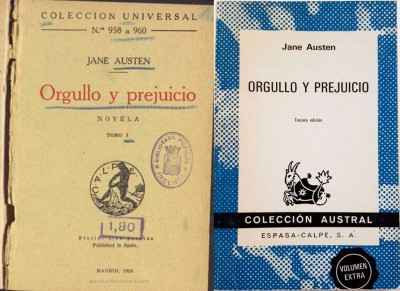
First edition in Spanish of Pride and Prejudice and edition from the Austral collection
As Juan Miguel Sánchez Vigil and María Olivera Zaldua point out, the Colección Universal precedes the Penguin Classics in English by more than fifteen years as a cultural project of offering affordable pocketbook editions to a wide audience. Merely a year after Orgullo y prejuicio first appeared, in 1925, Calpe merged with Espasa to become one of the most important publishing houses in the Spanish language; it still operates as a part of the conglomerate Grupo Planeta. Since its very beginning, Espasa-Calpe had distribution on both sides of the Atlantic, and thus its three Austen novels easily reached Latin America.
In her 2007 thesis, María Nieves Jiménez Carra found it strange that Espasa-Calpe did not issue a second edition of the novel until 1952, when Orgullo y prejuicio appeared in a single volume for the Colección Austral in Buenos Aires. She even doubted its existence (107, 112). Jiménez Carra’s account, however, like Díaz Bild’s, is restricted to Spain; unlike Díaz Bild, she seems to have momentarily forgotten the political, economic, and social disturbance in their country—in particular, the Spanish Civil War.2 Because of that war, the publishing literary industry in Spanish shifted, for a while, to Argentina and, in a lesser degree, to Mexico. In 1937 Espasa-Calpe’s Argentinian branch launched the Colección Austral, a hallmark in the publishing world in Spanish, which continued the work already started with Calpe’s Colección Universal, introducing several of the most important works in Western culture to Spanish speaking readers. Many of the works already published were reprinted, including their three Austen novels, with Orgullo y prejuicio being no. 1066 of the collection in 1952. Today Espasa-Calpe belongs to Grupo Planeta, and Austral is no longer a collection but one of its imprints.
Covers for both the Universal and Austral collections were straight and simple: in the case of Austral’s dustjacket, a blue frame indicating it was a novel. Austral’s color-coded design indicated the genre of its different publications: blue for novels and short stories; green for philosophical works and essays; orange for biographies; black for travel; yellow for politics; violet for poetry and drama; gray for classics; red for adventure, detective, and women’s novels; and brown for scientific works. At the bottom was its Capricorn logo, representing the Austral hemisphere.
For almost ninety years, Espasa-Calpe continued reprinting Urríes’s translation. One of its last was in 2000 with the addition of a prologue by Carmen Posadas. In 2012 a new translation was commissioned because all Urríes’s work had passed to the public domain. Because of the expiration of copyright, the Biblioteca Nacional de España can now offer a digital copy of this first translation on its website; Biblok reissued the translation in print form in 2014. More recently, in March 2023, Palabras de Agua reissued Urries’s translation as revised by Javier Martos. Not wanting to invest in a new translation or pay fairly for a more thorough revision, Palabras de Agua requested a simple revision only to correct the grossest mistakes (Martos).
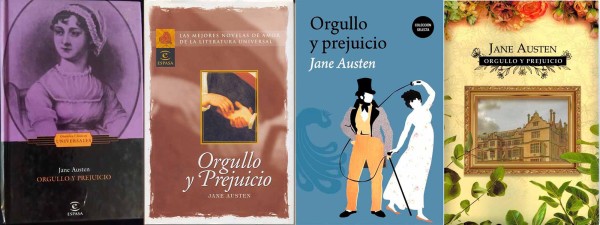
Editions using Urríes’ translation: Espasa-Calpe, Biblok, and Palabras de Agua
The influence of this first translation extends further than one might imagine. It has been used by other publishing houses without crediting the translator—even attributing the translation to other people; on close examination, however, the texts are based on Urries’s translation, with some modifications to disguise the “loan.” The reprise of Urries’s mistakes in translation, however, betrays it. In her doctoral thesis, Jiménez Carra recorded some of those mistakes (292–305). Among the most memorable are translating Bath as los baños [the baths], or Lizzy’s characterization as “an excellent walker” as excelente danzarina [excellent dancer].
Like many translations before the 1970s, Urríes translated many of the first names, turning four out of the five Bennet sisters into Juana, Isabel, María, and Catalina. Sir William becomes Sir Guillermo (and at times he is elevated to Lord Guillermo); his eldest daughter is Carlota; the Bingleys become Carlos, Luisa, and Carolina; George Wickham is Jorge, and so on. Mr. Darcy keeps his original first name. Lizzy and Kitty are never addressed as such, they are only Isabel and Catalina.
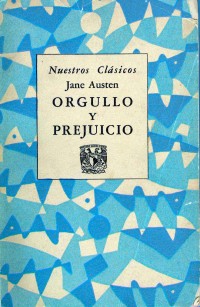
UNAM’s edition
One of the most notable “loans” of Urríes’s translation is the 1959 edition by the Universidad Nacional Autónoma de México (UNAM) as number 8 in its collection Nuestros Clásicos [Our Classics], with a prologue by the renowned Mexican writer Carlos Fuentes (1928–2012).3 This edition was examined by Andrew Wright and Jaime Alazraki in “Jane Austen Abroad” for the Jane Austen: Bicentenary Essays (304–06). They deemed it a poor, coarse translation plagued with mistakes and unfit for Latin American readers as its vocabulary is regional and restricted to Spaniards. The language they categorized as too familiar and informal: for example, many characters address each other as “tú,” the familiar second person singular pronoun, instead of the more formal “usted.” The prologue fairs no better in their judgment as it is barely “an informative document” (306).
With so many editions of the novel published by 1975, it would have been difficult to identify the translator for the UNAM edition, but the mistakes noticed by Wright and Alazraki make the task much easier. (It has been extremely disappointing to discover that my alma mater produced such a low-quality edition!) This edition seems an anomaly in Nuestros Clásicos, since it is very rare that the translator is uncredited in the collection. (I suspect Urries’s translation is also used for any other Orgullo y prejuicio editions whenever Fuentes’s prologue is reprinted and the translator not credited.)
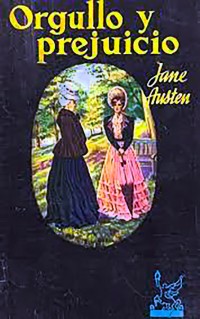
Acme’s edition, translation credited to Hilda Pina Shaw, based on Urríes
Then follow the rehashes. Not recorded by David Gilson, nor Díaz Bild, nor Jiménez Carra, apparently the second time that Orgullo y prejuicio was issued in Spanish was an edition by Bois in Buenos Aires in 1940. The translation is credited to Hilda Pina Shaw (1910–c. 1950), a Peronist writer, journalist, poet, and lecturer. Five years later, in 1945, it was reissued by Acme Agency (Gilson catalogues it as C203, but he misspelled the translator’s name). Constanza Galarza, on examining the text, has discovered Pina Shaw’s translation is based on Urríes’s, with slight modifications. It restores the first names to the original English—though not the diminutives Lizzy and Kitty—and repeats Urries’s semantic mistakes. After a few years this translation would get through a revision and be credited to another person.
Most importantly, the editions of Orgullo y prejuicio from the different Penguin Random House imprints are also based on the Urries translation—although translation is credited to Ana María Rodriguez. These include the popular Debolsillo editions, its Penguin Clásicos edition with Tony Tanner’s introduction, the Alfaguara edition illustrated by María Hesse, and, more recently, a new abridged and illustrated Molino edition. Initially, this version, based on the old translation, was first issued by Plaza y Janés in 1997, as number 331 of its Jet collection. All six of Austen’s novels were to be published in that collection, at last by a single publisher, and all would sport covers taken from screen adaptations. In the case of Orgullo y prejuicio, a promotional still from the 1995 BBC miniseries featuring the main protagonists was used. It is strange that Plaza y Janés chose to rehash Urríes’s translation, since—as we will see later—one of its predecessor companies (G. Plaza) already owned another translation of the novel.
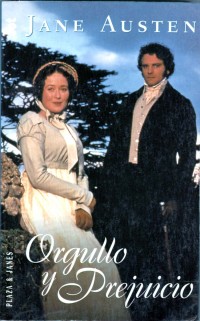
Plaza y Janés edition, translation credited to Ana María Rodríguez, based on Urríes.
As happened with the other two Austen novels (Sense and Sensibility and Emma) that Rodríguez also “translated,” it seems that she did not bother to look at the original English text; instead, she took the oldest translations, modernized syntax and some vocabulary, and reestablished first names to their original form in English—probably that is why Jiménez Carra did not notice the “loan” and reported it as a new translation (120, 361–62). Rodríguez did not bother to correct the many semantic mistakes in Urríes’s translation, like the translation of Bath as los baños and the description of Elizabeth as an excellent dancer [Urríes: danzarina; Rodríguez: bailarina], instead of “an excellent walker,” and others.
Plaza y Janés was acquired in 2001 by Random House. Since then, Penguin Random House has used Rodríguez’s version for its different imprints of the novel, changing only the covers. With all its resources, it is incomprehensible that the conglomerate does not invest in new and good Austen translations. In fact, its carelessness extends to the point that the Penguin Clásicos edition includes only eleven notes, those that appear in Tanner’s introduction (translated by Sílvia Pons Pradilla) but none for the novel. These editions do not match the quality traditional to the original Penguin Classics line.
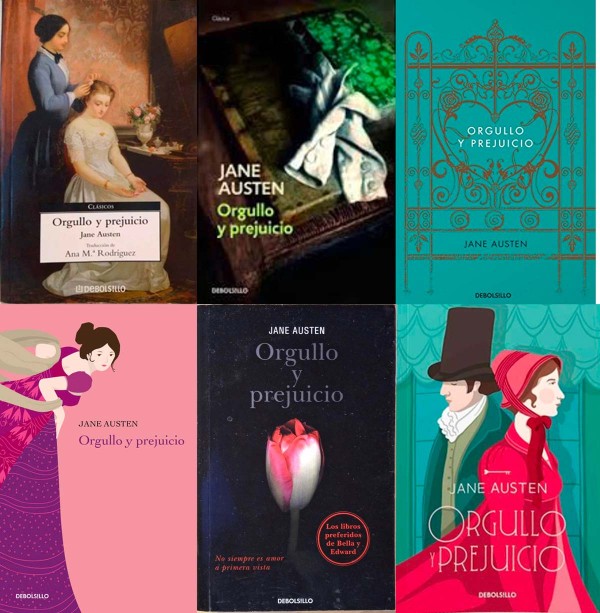
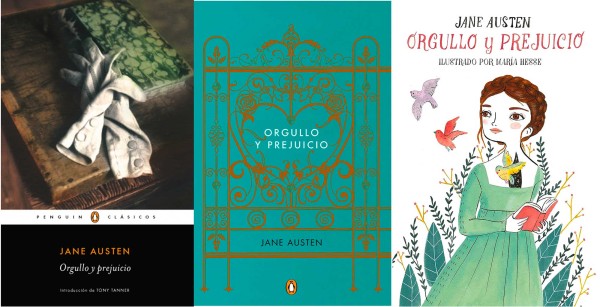
Debolsillo, Penguin Clásicos, and Alfaguara editions
Taking a page from Penguin Random House, since 2011 Grupo Editorial Tomo in Mexico has based its own editions of Orgullo y prejuicio on Rodríguez’s revised version of J. Urríes’s translation, in its turn crediting the translation to Roberto Mares, with slight modifications to disguise the “loan” but keeping the same semantic mistakes of the old translation.
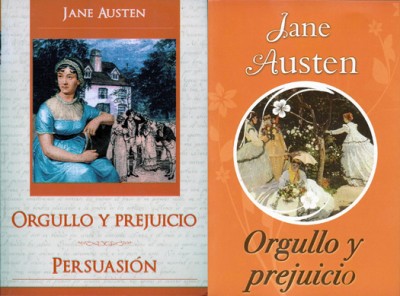
Tomo’s editions, translation credited to Roberto Mares, based on Rodríguez, who also based her translation on Urríes.
The 1940 movie adaptation and pinking Austen
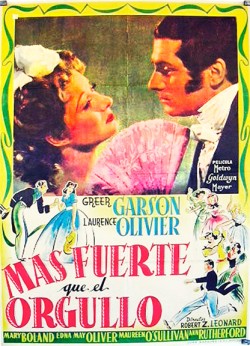
Spanish poster of MGM’s 1940 movie adaptation.
If with Espasa-Calpe, Orgullo y prejuicio acquired a stable position among Spanish-speaking readers, the cinematographic adaptations catapulted the novel to the top. In Spanish-speaking countries, the 1940 movie was titled as Más fuerte que el orgullo [Stronger than Pride]. It was released with subtitles in 1941 in Latin America, whereas, as Romero notes, it was not released in Spain until 1944 (Historia). Perhaps dubbing caused its delayed release in that country. Under its influence almost ten different editions of the novel were published both in Latin America and Spain.
In 1940 in Argentina, in addition to the Bois edition with Pina Shaw’s translation based on Urríes, Juventud Argentina—a branch of the Spanish publishing house Juventud—in preparation for the movie’s release also published Orgullo y prejuicio as number 42 of its collection Biblioteca Primor. The translation is by Irene Polo I Roig (1909–1942), a Catalonian journalist and translator, who went into exile to Argentina with the Spanish Civil War. This is really the second ever Pride and Prejudice translation into Spanish, and it has a quite interesting history, as documented by Teresa Julio. Like Espasa-Calpe, during the war in Spain, Juventud transferred part of its publishing operations to Argentina. The Biblioteca Primor reprinted several titles already published by Juventud in Spain, but Orgullo y prejuicio was among the few works published first for the Argentinian collection, the only translation by Polo for the imprint, and the only one she made from English. As a translator, Polo mainly worked for Editorial Losada, another Argentinian publishing company established in 1938 and known as “the publishing house of the exiled” (Julio 89–90), for whom she translated French works.
As was customary, Polo also translated the first names (Julio 94); however, Lizzy is translated as Isabelita and Eliza does not appear, while Kitty remains only as Catalina. Julio comments that the translated text is “fluent and naturalistic” with “numerous colloquial turns, especially in the conversations, fragmented dialogues.” Since the translation tends to “simplification,” Julio suspects that Polo might not have been translating directly from English but from a French translation (93–94).
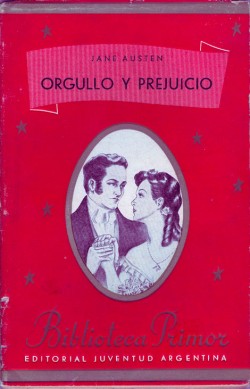
Dustjacket of Juventud Argentina edition
Biblioteca Primor [Beautiful Sight/Thing Library] started in 1938 as a collection of “novela rosa,” novels with a romantic plot for female readers that aimed to become bestsellers through a paperback pocketsize format with affordable prices (Julio 92). While the white covers with a blue border were simple, they also included decorated dustjackets: a colored starry background and at the center a medallion representing a scene from the book. Orgullo y prejuicio has a red dustjacket with a medallion portraying a Victorian couple holding hands. The illustrated cover of this edition proves Juventud and its Argentinian branch had inaugurated the pinking Austen period described by Janine Barchas (220–25). To a certain extent, Spanish-speaking readers have not yet cast aside this categorization of Austen merely as a writer of romance novels.
The Biblioteca Primor edition is the only time (not counting a 1943 reprinting) that Polo’s translation is credited, but Julio has discovered that the text for the Más fuerte que el orgullo edition published in 1945 by Juventud in Spain exactly matches Polo’s translation (94). Barchas provides a description of this especial edition, number 121, of Pride and Prejudice in Spanish for the collection La Novela Rosa (221–24); she was unaware that Julio had recently identified the translator. Julio assumes that Polo’s name was intentionally suppressed by Juventud to obtain governmental approval for the publication of the novel: the translator had opposed Franco’s dictatorship; her sexual orientation was not accepted, and she committed suicide in 1942 (95–96). The cover of this edition from Spain sports a dancing couple in a late Victorian attire in pink overtones.
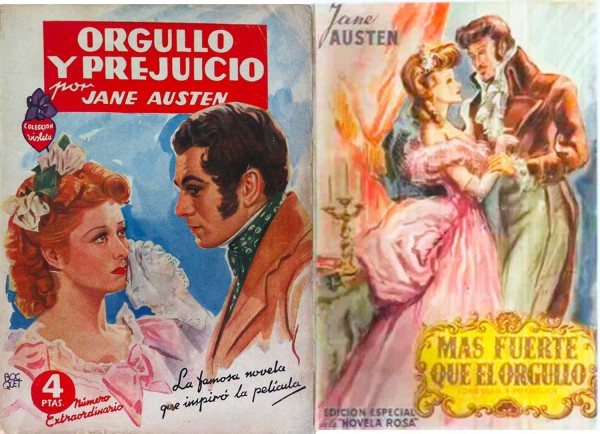
Molino and Juventud editions in Spain
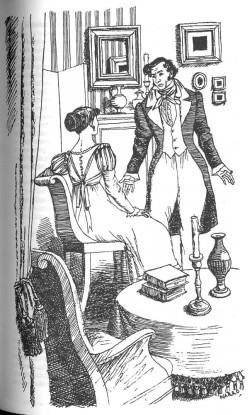
An illustration by Narro for the Juventud edition in 1956
The story of Polo’s translation does not end there. In 1956 Juventud applied for permission to reissue the novel for its pocketbook Colección Z, restoring the literal translation of the title: Orgullo y prejuicio. The translation remained uncredited, but this reprinting has an extra feature: it was one of the two first illustrated editions of the novel in Spanish, both published in 1956. Josep Narro i Celorrio (1902–1994), a Catalonian artist who, like many others, immigrated to Latin America (in his case, Mexico) during Franco’s regime, created eight black-and-white illustrations for the novel, plus one for the cover, which kept the pink background. Narro’s illustrations are not rosy but starker than one would expect. Unlike the other illustrations released in 1956, the characters are in Regency attire.
Juventud continues to reprint the novel (with different covers) with Narro’s illustrations and has registered Fernando Durán as translator. Julio wonders if he is the same Durán credited as the 1943 translator of Cordura y sensibilidad (see García Soria), but the text matches Polo’s translation, including the mistaken translator’s note for the special license that Barchas reports (224) and that Jiménez Carra also noticed in other translations (283–84).
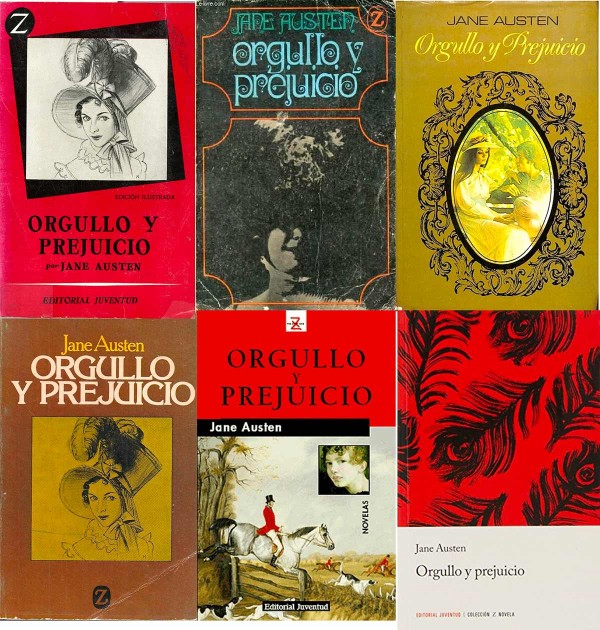
Juventud editions, translation credited to Fernando Durán (but matching Polo’s)
Jiménez Carra (113–14, 117, 361) reports that the translation in the Juventud edition strongly resembles the 1944 Molino edition (Orgullo y prejuicio) and the 1945 Plana edition (Más fuerte que el orgullo), with slight variations to disguise the loan. She was not aware that the translation from Juventud Argentina predates the ones from Molino and Plana. Barchas assumed the translation from Molino was an “in-house workmanlike translation by the Editorial Molino firm” (224–25), but now we know that they had “borrowed” it from another publishing house. (Molino’s founder had worked at Juventud.) Molino is now one of the Penguin Random House imprints.
As Barchas points out, the 1944 Molino edition also belongs to the pinking of Austen period. It was no. 38 of the Colección Violeta, a collection of novels written by and published for women (Rodríguez Fernández). Joan Pau Bocquet Bertrán (1904–1966) designed the cover for this edition and a black-and-white illustration at the beginning of chapter 1, both clearly inspired by stills from the movie.
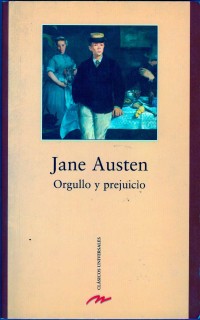
Mestas edition in 2002
Polo’s translation was not only recycled by Molino and Juventud in Spain. Jiménez Carra noticed the translation in a 2002 edition published by Mestas Ediciones and credited to Kiki Rodríguez: the text resembles the translation used by Molino and Juventud with slight modifications (121–22). This 2002 Mestas edition includes Virginia Woolf’s essay on Austen from The Common Reader: First Series as an introduction; the translation of the essay is credited to Pedro Donoso. Mestas used a detail of Manet’s Luncheon at the Studio (1868) for the cover. This was the only time Mestas used this translation; in subsequent editions it was replaced, as was Woolf’s essay, and new covers were used.
The third Spanish translation of Pride and Prejudice is the 1943 Orgullo y prejuicio edition by M. Arimany, translation by R. Berenguer—pseudonym of Pau Romeva (1892–1968), an experienced Catalonian pedagogue and translator.4 With Orgullo y prejuicio the newly born publishing house M. Arimany inaugurated its Colección Aldebarán, a selection of the most well-known novels in world literature along with more recent titles (Llanas177). The edition was more high-end than previous ones: published in hardback format with dustjacket, it included a three-page prologue prepared by the translator himself. The dustjacket included an illustration by Daniel Leo. Arimany reprinted the novel three times in the following ten years (Gilson 203). Boosted by the motion picture, the novel was retitled Más fuerte que el orgullo, and the cover illustration was replaced with another inspired by the movie. The publishing house also released three other Austen novels for the collection: the first Spanish edition of Emma (1945), La abadía de Northanger, and the first unabridged En el parque Mansfield (1954). M. Arimany, however, seems only to have had distribution in Spain: it is extremely rare to find copies of its editions on this side of the Atlantic.
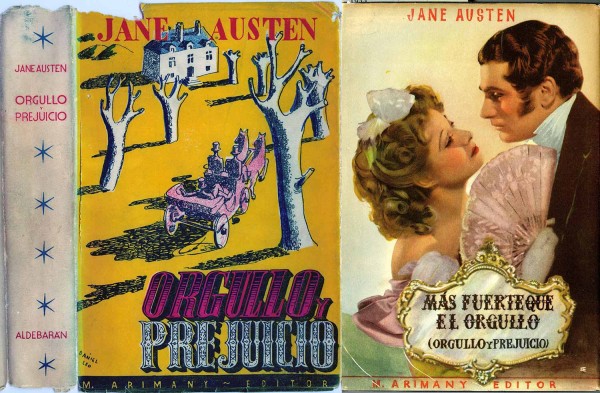
Arimany editions
According to Marta Grueso Coy, Berenguer’s translation seems to follow the literal translation method (closer to the original text in English, rather than adapted to the reader) with several loans and replacements. For example, Mr., Mrs., and Miss remain, rather than Sr., Sra., and Srta. The first names, however, are translated to Spanish. Berenguer/Romeva seems to have been more aware of British geography and history than previous translators—at least he did not translate Bath as los baños.
Berenguer’s translation was also reproduced in Maestros Ingleses, issued by Planeta in 1961, a deluxe, red-leather-bound, six-volume collection of great British writers—ranging from Chaucer to Graham Greene—and printed on Bible paper. Orgullo y prejuicio is included in the second volume along with Fielding’s Tom Jones, Goldsmith’s The Vicar of Wakefield, and Charlotte Brontë’s Jane Eyre. Austen, the Brontës, George Eliot, and Virginia Woolf are the only female writers in this collection.
Unexpectedly, Berenguer’s translation was rehashed in 1973, when Mundilibro issued a collection of great novels that included Orgullo y prejuicio. The collection was issued in hardbound with dust jackets, and several titles, including this novel, were credited to the translator Xavier Costa Clavell. It was illustrated by Ma. Paz García Borrón (1927–?). Copies of this edition are hard to find, even more so with their dustjacket, but Janine Barchas owns one and finds its design striking. As she points out, “No one would mistake the cover illustration for an intentional representation of Lizzie, or even Lydia.” The inspiration, Barchas suspects, is Brigitte Bardot in Le Mépris (190–91). Barchas believes this cover illustration to be the only contribution of García-Borrón to the book; however, García-Borrón is not the artist responsible for the cover, which does not correspond to her style. She created six line-drawings in sepia for the edition, and they are inspired by the Regency style.
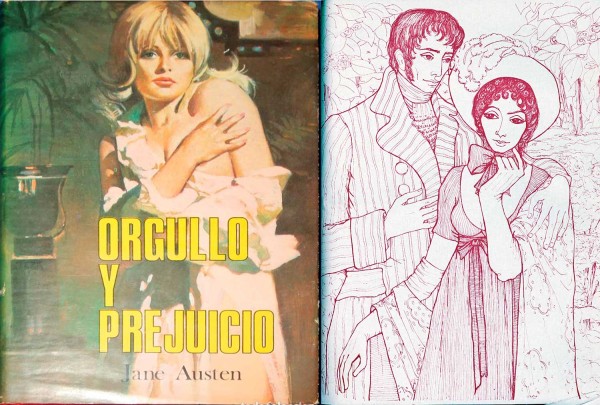
Mundilibro edition and illustration by García Borrón
Costa Clavell (1923–2006) was a prolific Galician author, journalist, and translator, who translated among others Mérimée, Maupassant, and Melville (Jiménez Carra 119). I would never have doubted he had translated Pride and Prejudice since both Gilson and Jiménez Carra reported it as a direct translation from the English. On examining the text, however, it’s clear that Costa Clavell’s “translation” is more than a 90% match for Berenguer’s: it only differs in that Clavell, unlike Berenguer, chose to translate courtesy forms of address, like Mr., Mrs., and Miss to señor, señora, and señorita as well as translating Sir William and Lady Catherine to don Guillermo and doña Catalina—which are not proper title equivalents. The opening paragraphs of the novel are also different, although thereafter Costa Clavell closely follows Berenguer’s wording.5 The translation was credited to Costa Clavell a second time in 1986 by Salvat as no. 4 of its collection Novela y Ocio [Novels and Leisure]. It is a paperback edition with a cover illustration representing a couple in Regency attire.
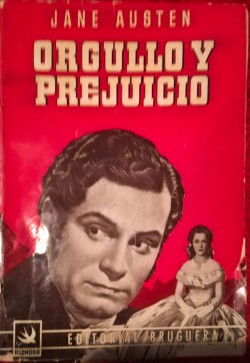
Bruguera edition
In 1945, two more Orgullo y prejuicio editions would appear, one released by Bruguera, the other by Reguera. Bruguera was one of the most prolific publishing houses in Spain, “famous for its comics, romantic novels and westerns” (Herrero López 246); as María José Crespo Allue put it, it did not stand out for its high literary quality (451). Bruguera tried to capitalize on the 1940 motion picture with the release of the same three Austen novels Espasa-Calpe had already published. Bruguera released them in 1945 as part of its Colección Alondra [Lark], one of its many paperback collections aimed at female readers; translations were credited to Juan Ruiz de Larios. Josep Mengual Català dates the beginning of this collection to the early 1950s; however, the three Austen editions indicate that it began in the mid-1940s. Bruguera also color-coded the covers for this collection: red for classic literature (novels, short-stories, theater, and poetry); pink for female novels. The covers of the Austen novels have a red background, a small logo representing a lark, and black-and-white photos of characters in Victorian attire—in the case of Orgullo y prejuicio, Laurence Oliver and Ann Rutherford (who played Lydia), not Greer Garson!
There is little biographical information on Ruiz de Larios, but there are several translations credited to him. His Orgullo y prejuicio translation was not considered by Jimenez Carra, but, as Crespo Allué and Isis Herrero López have noticed, his Persuasión and La abadía de Northanger seem to be based on Ortega y Gasset’s and Oyárzabal’s translations, respectively. I have not been able to get my hands on a copy of this edition, but it seems safe to assume that his Orgullo y prejuicio is based on Urríes y Azara’s translation—that is, not a bona fide translation. Furthermore, Herrero notices that his version of Northanger Abbey rather blunts Austen’s irony and assigns a more conventional role for the female characters (247, 249). I cannot but wonder what changes he must have made to Elizabeth Bennet to suit the conservative tastes of Francoist Spain.
Reguera issued its Orgullo y prejuicio edition as number 22 of its Colección Oasis, translation by Javier de Zengotita and cover credited to Roc Riera Rojas (1913–1992), although the signature on the cover says “Moreno.” The illustrated cover is inspired by the 1940 movie, supposedly representing Greer Garson as Elizabeth Bennet. It is a paperback edition, like Cordura y sensibilidad released one year later. Again, there is not much biographical information regarding Zengotita, but he was an experienced translator. Jiménez Carra notes that he offered more footnotes explaining cultural issues to readers than any previous translator of Orgullo y prejuicio. He seems to have avoided some of the semantic mistakes that his colleagues had incurred. He also preserved the diminutives Lizzy and Kitty, though other first names were translated.
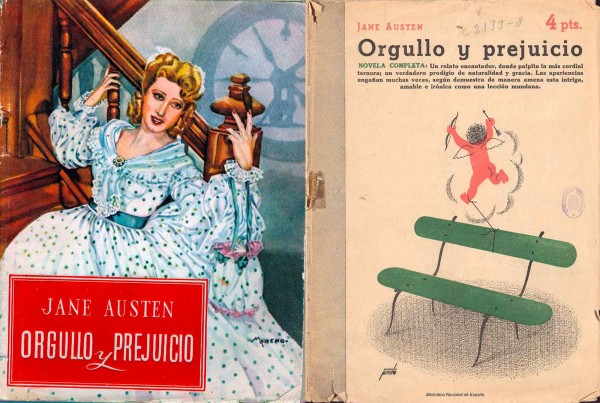
Reguera and Revista Literaria editions
As Jiménez Carra reports, the text of a 1949 Orgullo y prejuicio edition issued by Diana Artes Gráficas closely follows Zengotita’s translation with minor alterations in syntax and collocations to disguise the borrowing (115–16, 361). In fact, it is number 948 of the weekly magazine Revista Literaria Novelas y Cuentos, the first of four Austen works to be issued by this magazine and printed in barely 55 pages. Although Gilson wondered if it was an abridged edition, it is not: the secret is a very tiny font. The cover of this edition was designed by Manuel “Manolo” Prieto Benítez (1912–1991), one of the most famed Spanish graphic designers, and it depicts Cupid tied by the foot to a park bench. Spain’s National Library has released this edition in digital version.
Between low-cost and highbrow editions
The success of Pride and Prejudice among Spanish-speaking readers continued strong in 1946. Two Spanish-language editions were published and have become the most influential in Latin America. They are on the other end from most of the pulp editions published in the 1940s; in fact, though they were issued during the “pinking Austen” period, they put Jane Austen in the major leagues of world literature for Spanish-speaking readers.

Volume 6 of Grandes Novelas de la Literatura Universal featuring Austen’s Orgullo y prejuicio and Gaskell’s Cranford
In Buenos Aires, W. M. Jackson Inc. Editores issued a luxurious hardbound collection of Grandes Novelas de la Literatura Universal [Great Novels of World Literature] in forty volumes, coordinated by Ricardo Baeza (1890–1956), an exiled Cuba-born Spanish intellectual who prepared prologues for all the volumes. The sixth volume of the collection, titled Dos novelistas inglesas [Two English Female Novelists]—Jane Austen and Elizabeth Gaskell—featured Orgullo y prejuicio and Cranford, with translation credited to Américo Nos Gray. His identity seems to be enveloped in mystery: we do not know his nationality, and his name only appears for these two translations. Since this translation closely follows Pina Shaw’s revision of J. Urríes’s translation, it is safe to assume Nos Gray was a name invented to hide that this translation is a copy of a previous one. Whoever Nos Gray was, the text (unlike in the case of Pina Shaw) was revised to amend the mistakes made by J. Urríes. In this translation Elizabeth is again a great “walker,” and Wickham goes to Bath, not the baths.
As Jackson Inc. had branches all over the Americas (New York, Rio de Janeiro, Mexico City, Havana, Caracas, Bogota, Lima, Santiago de Chile, and Montevideo), the collection was treasured among cultured Spanish-speaking readers of many countries. It was printed and reprinted several times in the 1950s and 1960s by Jackson and its associated publishing houses, such as Cumbre in Mexico and Gráfica Editora Colón in Panama; it even reached Spain through Éxito in 1952, the latter listed by Jiménez Carra (116, 361), who observes that the edition does not include any footnotes. This translation was reissued in Spain in 1984 by Planeta Editores for its Grandes Novelas de Amor de la Literatura Universal collection, which was sold weekly in newsstands. (Romeo and Juliet was also included in this collection of novels!) More recently, in Mexico, Orbilibro and Librerías Gandhi have reprinted this translation accompanied by an introduction by Juana Inés Dehesa.
Furthermore, other editions credited Nos Gray as translator: Cumbre issued the novel in a hardbound edition in 1956 in Mexico for the Colección Ilustrada de Obras Inmortales, which included at least thirty-one unnumbered, illustrated volumes, with illustrated green dustjackets. Among the many artists collaborating on this project was José Luis Florit Rodero (1909–2000), one of the most renowned Spanish painters of the twentieth century, whose career ranged from book illustrations to watercolor and oil paintings and murals. Florit illustrated at least ten volumes of the collection, including Orgullo y prejuicio, for which he designed eight colored illustrations (one repeated on the green dustjacket) and sixteen black-and-white drawings, for a total of twenty-four illustrations. Their quality is not bad; however, Florit seems to have been completely unaware of Austen’s historical period. He represented the characters in Victorian attire more suited for Little Women. Again, these illustrations show how much influence the 1940 adaptation had for the Spanish-speaking public and how little we knew about Austen during most of the twentieth century. The collection was extremely successful: the volumes were reprinted several times during the 1950s and 1960s, and copies were distributed in all Latin-America and Spain.
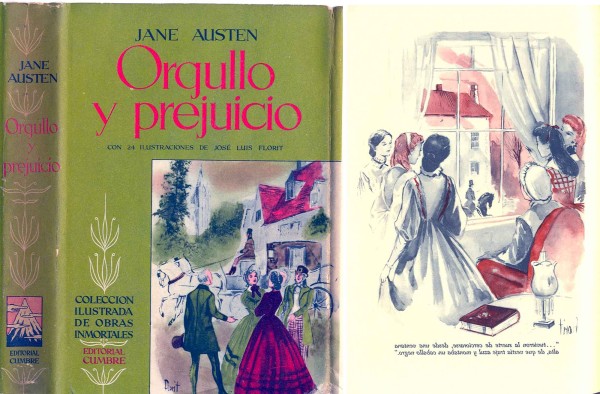
Dustjacket of the Cumbre edition and an illustration by Florit
Finally, the other important Orgullo y prejuicio translation and edition, published in 1946, was issued by Editorial Aguilar as No. 186 of its Colección Crisol [melting pot]. The translator was Amando Lázaro Ros (1886–1962)—not Armando nor Amado, though in Latin American editions he is credited as Armando. Established in Madrid in 1923, Aguilar was one of the oldest and most prestigious publishing houses in Spanish, with distribution on both sides of the Atlantic; thus, its editions had a wide reach. In 2014 Aguilar was acquired by Penguin Random House, but they have not used Lázaro’s translation since the acquisition.
Crisol, started in 1943, was one of Aguilar’s signature collections, a luxurious, but best-selling, pocketbook collection featuring the best of world literature. The volumes are leather bound, slim, and small as they were printed on Bible paper. Like the Austral collection by Espasa, Aguilar assigned colors according to the literary genre of the titles—red for novels, short stories, biographies, travel journals, and adventure novels (Blas Ruiz). Each volume included a preliminary note on the author and a rotogravure plate as frontispiece. Orgullo y prejuicio featured the Victorian Austen portrait—so again, as in the rest of the world, that became the most common image of the writer for Spanish-speaking readers. Lázaro wrote the prologue. This Aguilar edition was in so much demand that it was reprinted twice in the Crisol collection, in 1957 and 1962.
Lázaro Ros was perhaps one of the most renowned translators of his time. He initially worked as a journalist, and his translations were a side job. His political left-wing convictions made him oppose Franco’s dictatorship. He was incarcerated and later forbidden to continue his career as a journalist. Lázaro was among the few who chose not to go into exile. He focused on translating, mainly for Aguilar, though he also became novelist, essayist, and playwright. He translated mainly from English but also from French and Italian (Guzmán Mora).
In her assessment of his Pride and Prejudice translation, Jiménez Carra considers that, despite Lázaro’s vast experience, he naturalized the text for the Spanish reader by introducing elements not originally written by Austen, distorting the general tone of the novel (306). Among translation errors, she detects changes of meaning, omissions, additions, and colloquialisms (307–16). But, for the average twenty-first-century reader, the most disconcerting translation decision by Lázaro is the translation of first names. This was customary in the earlier part of the twentieth century (as we have seen), but Lázaro went further, turning Elizabeth’s hypocoristic Lizzy and Eliza into Bebel and Isa, and Kitty into Catiti.
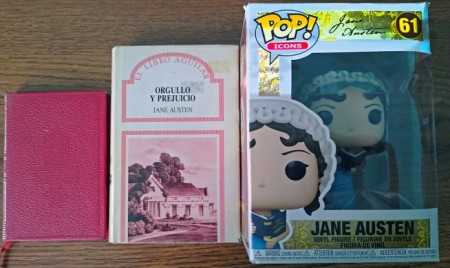
Aguilar pocketsize editions
In 1987, Aguilar reissued the novel, including Orgullo y prejuicio as number 23 of its El libro Aguilar collection, in an attempt to recover part of its bibliographic trove. The volumes are hardback pocket-size, but, since the paper is thicker than that used for Crisol, the volumes are not as slim. They also sport an elegant, white, illustrated dustjacket. For Orgullo y prejuicio, a reproduction in red tones of the plate “A Vicarage House” from Ackermann’s Repository of Arts, Literature, Fashions, Manufactures, &c. (October 1816) was selected. (The credits say 1818.) The blurb at the back of the dustjacket is plagued with spoilers, revealing the pairings of the three Bennet sisters married by the end of the novel. There’s no surprise for first-time readers—myself included at the time—that Darcy is the protagonist. Apparently, Lázaro’s translation was revised for this edition, though the only noticeable modification is that the first names were restored to their original English; his prologue is not included. As with the Crisol edition, copies of this collection were also sold on both sides of the Atlantic.
In Spain, other publishing houses used this translation in later decades, first Editorial Ramón Sopena in 1972, then Óptima in 1998, and Suma de Letras in 2001 (Jiménez Carra 362). If Aguilar’s reach was not enough, Lázaro’s translation was also used in Latin-American editions of the novel widely distributed across the region. Thus, it can be said that Lázaro’s translation was the novel that Latin American readers knew during a great part of the second half of the twentieth century.
The Centro Editor de América Latina (CEAL), for example, published it in two volumes for its Biblioteca Básica Universal collection, first in 1969 as numbers 63 and 64 and then again in 1979 for the second series as numbers 52 and 53. The CEAL was established in 1966 during a period of dictatorship in Argentina; in fact, in 1980 many of its books were burned. Its cultural aim was to provide “more books for more [people],” a project to promote readership among the middle and lower classes in Argentina at affordable prices, and it managed to publish around 5,000 titles in 79 collections. Each title began with a print run of at least 20,000 (Gociol 10, 19).
CEAL’s staff acknowledged that they used to take old translations and modify the style to avoid detection (Gociol 28–29)—a practice still prevailing among publishing houses on both sides of the Atlantic. Since Lázaro is duly credited for the translation of Orgullo y prejuicio, I would not suppose his was revised, but I cannot confirm it was used with his heirs’ permission. For the covers of its editions, CEAL first used one of Thomson’s 1894 illustrations and the plate “Two Ladies, en neglige, taking an airing in a phaeton” from Nikolaus von Heideloff's The Gallery of Fashion (August 1794). In 1979 these were substituted with details from John Constable’s paintings Dedham Lock and Mill (1820) and Flatford Mill or Scene on a Navigable River (c. 1817).
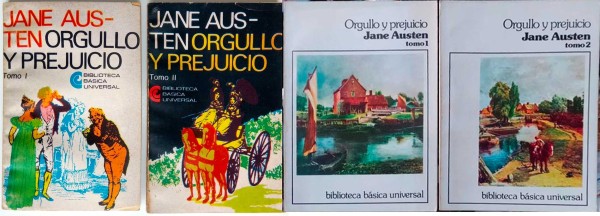
Covers of CEAL editions
In 1984, Editorial Porrúa also used Lázaro’s translation for another Orgullo y prejucio edition in Mexico: number 431 in its “Sepan Cuantos . . .” [Who Knows How Many] collection. Porrúa is one of the oldest Mexican bookstores and publishing houses, and Sepan Cuantos . . . is one of its most emblematic collections, with a long tradition in the country. Probably all literate Mexicans own or have owned at least one volume of this collection (if not more), since from elementary school to university we have always been assigned titles from it. The collection began in 1959 and has reached over 750 titles (and is still counting).
Despite all this, as Lili Atala García has pointed out, the importance of Sepan Cuantos . . . in the promotion of reading and dissemination of culture in Mexico and other Latin American countries has been continually disregarded—even disparaged—in the book and reading history of the country (1–7). Atala rescues the opinion of another scholar, Ignacio Sánchez Prado, that the collection offers something like a canon of world literature through low-cost, affordable, and widely distributed paperback editions (7). Furthermore, Atala contends that in this mishmash collection of world classics, translations play an important role, as more than 400 of the volumes were not written originally in Spanish (8, 45, 322–23).
To keep the costs low, Sepan Cuantos . . . editions are printed on pulp paper (the same used for newspapers), in small font and initially double-column pages; the cover design is simple and even austere, and, like other publishing houses, Porrúa color-codes books according to themes in the upper block, where the author and the title are placed; the bottom half is white with Porrua’s logo, a gravure of an Aztec eagle warrior designed by the Mexican artist Saturnino Herrán (1887–1918) at the center.
This edition of Orgullo y prejuicio includes a prologue by Sergio Pitol Doménegui (1933–2018), a Mexican intellectual and award-winning author. Contrary to Atala’s assumption (248–51), Pitol’s prologues for Sepan Cuantos were not originally written for the collection but are recycled. His Austen essay was prepared in 1968 during his stay in Belgrade as cultural attaché of the embassy of Mexico in the former Yugoslavia and was first published in 1975 in De Jane Austen a Virginia Woolf: seis novelistas en sus textos, a compilation of his essays on English novelists. He also translated Emma (1972), about which I hope to write in the future.
Since 2000, Porrúa has been updating the collection’s design with a cover image on the top-colored block, abandoning the double column format for a single column, using a larger font, and printing on better-quality cream paper (Atala 217). By 2000 the publishing house had reprinted Orgullo y prejuicio ten times in paperback format, and it also had a run in hardcover—proof that the novel had acquired a solid position in the Sepan Cuantos . . . catalogue. For the eleventh reprinting, in 2011, an e-book version was also released with the novelty that the translation had been slightly revised: the characters’ first names were restored to their original English form.
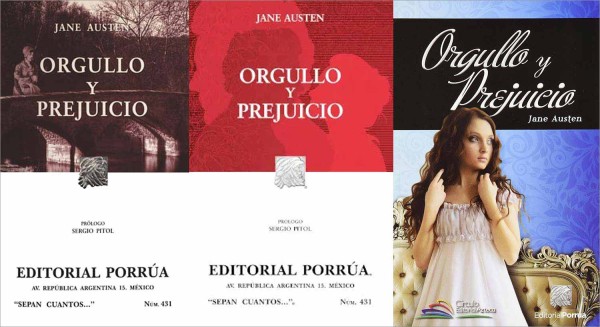
Porrúa editions
Orgullo y prejuicio is the only Austen novel, Porrúa has published. In 2014, it also issued the novel in co-edition with Círculo Editorial Azteca—part of Grupo Salinas, a Mexican media broadcasting company—with a prologue written by Paty Chapoy, a gossip and celebrity journalist and TV host (not a high-brow choice). This publishing house tends to recycle old translations of works originally written in English to keep costs low.
In 2013, Lázaro Ros’ translation was reissued in Chile for the Viva Leer Copec [Hurrah to Reading] collection published by Origo. Copec is a Chilean gas-station company, and Viva Leer is one of its social programs to encourage reading by issuing low-cost editions of world literature that can be purchased periodically at its gas stations. This particular Orgullo y prejuicio stands out because it is a hardback edition with full color illustrations by the Chilean artist Jazmín Espinoza, also known as Jazcinta. For a while, copies of the edition could be found outside Chile, but now it is out of print.
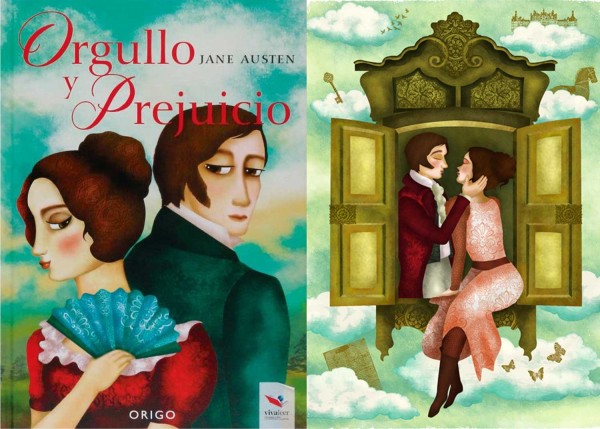
Origo edition and an illustration by Espinoza
The third quarter of the twentieth century
As we have seen, by the mid-twentieth century, Orgullo y prejuicio had acquired a stable position among Spanish-speaking readers, being the most published Austen novel. During the following four decades—until the dawn of Austenmania—it would be the only one of her works that was never out of print. There were many reprintings and new editions. The handful of new translations—at least one each decade—had a more limited reach than those issued in the 1940s.
In 1956, Ediciones G. P. or Ediciones Plaza (Germán Plaza [1903–1977] was the founder) issued Orgullo y prejuicio for its collection Enciclopedia Pulga [flea]. Three years later Ediciones Plaza merged with Janés to become Plaza y Janés. One peculiarity of this collection is its size—thus the name “flea,” tiny volumes of no more 2.75 × 4 inches—due to the shortage of paper in Spain at the time (Mengual, “Germán Plaza”). Enciclopedia Pulga included a variety of genres: biographies of great figures in Spain, popular science, and classics of world literature (Palmer). The collection became quite the rage in Spain thanks to its affordable prices and large print runs. Plaza himself defined the criteria for selection: literature not of magnificent proportions (neither sophisticated nor of great length or abstract content) but of cultural stature and ambition suited to the limited education of the reading public. The idea was to avoid scaring the public but to present simple subjects of permanent interest in straightforward and intelligible language (Mengual, “Germán Plaza”). We could argue whether Austen really fits such criteria. In any case, Orgullo y prejuicio was included.
This Orgullo y prejuicio was translated by Héctor de Santisteban, who had also written a few biographies for the collection, but Orgullo y prejuicio seems to have been his only translation. No biographical data for him can be traced. His Pride and Prejudice translation was never reproduced. It was really the only new translation of the novel issued during the 1950s. Other editions are reprints and rehashes of previously published translations. The covers of the Enciclopedia Pulga were designed by either Javier Chacopino Fabre (1926–2014), also called Chaco, or Alexandre Colli Blanch (1898–c. 1975). I cannot ascertain who did the Orgullo y prejuicio cover. It is more accurate than many others, depicting characters attired in Regency clothes leaving a ballroom after supper has been announced.
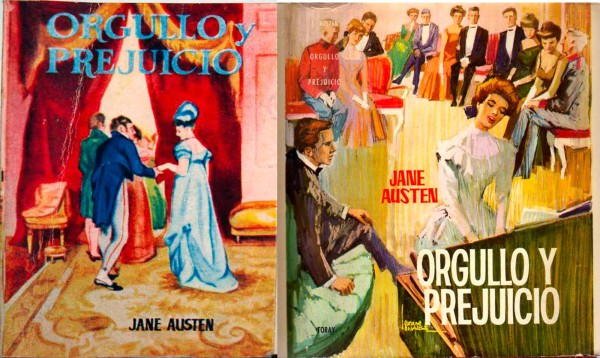
Plaza and Toray editions
In 1963, Ediciones Toray issued a new translation of Orgullo y prejuicio, by José Villalba Pinyana. Little can be found about him online. Born c. 1904 in Tarragona and by profession a lawyer, Villalba was one of the many intellectuals exiled from Spain after its Civil War; he arrived in Mexico in 1941. He wrote a book on landscapes of Mexico and Spain, and he is credited with several translations of literary classics, including by Charlotte Brontë and Dostoyevsky. Jimenez Carra does not mention anything notable about his Orgullo y prejuicio, beyond its including three cultural footnotes (118). Apparently, this edition is the only time this translation was used, and it is worth mentioning that Toray specialized in publishing comic books (or as they are called in Spain, tebeos) and popular literature, so it was not a high-brow publishing house. Orgullo y prejuicio was number 12 in its Novelas Maestras collection, and the cover was illustrated by Desiderio Babiano Lozano Olivares (1909–1985), an artist who was incarcerated in 1939 before he could escape into exile. Once liberated, he left his father’s last name (Babiano) behind as a protection and adopted his mother’s family names to sign his works (Lozano Olivares). Unfortunately, his cover design for this novel is not historically accurate: it depicts a group of people listening to a piano performance, attired in twentieth-century evening dress.
The following year (1964), Editorial Mateu published Orgullo y prejuicio as no. 130 of its Colección Todo Para Muchos [Everything for Many], translated by M. Villamuera de Castro. As Jiménez Carra points out, Villamuera is credited with translations of Shakespeare (Romeo and Juliet) and Stendhal (La Chartreuse de Parme) among others (119), but nothing more can be found about Villamuera, not even his or her first name. The cover was designed by Luis Acosta Moro (1941–2014)
The mystery surrounding Villamuera stretches further, as Gilson records two editions in 1973 related to this translator and the publishing house, one by Autores-Editores de Obras Proprias [sic] in Madrid, credited to Villamuera as C212, of which I have found no copy so far; and another Orgullo y prejuicio edition, C214, by Mateu in Barcelona. For the Mateu edition, no translator is stated; this one is the last Gilson records in his list of translations of Pride and Prejudice in Spanish. Mateu issued no. 39 of its Arco Iris collection. Jiménez Carra did not find copies of these editions, but she traced a 1973 Nauta edition published in Barcelona and a 1973 G. Riesgo edition of the novel in Madrid for which the translator is not credited, but she noticed the text in both editions matches exactly that of a 1984 edition published by Sarpe in 1984 for which Villamuera is also credited as the translator (118–119, 361–62). This information would suggest that at least five different editions used Villamuera’s translation; however, Jiménez Carra did not know that Mateu was acquired by Nauta in 1973—thus Mateu had become a Nauta imprint, and both companies appear on the legal page of the 1973 edition (Trejo Peña).
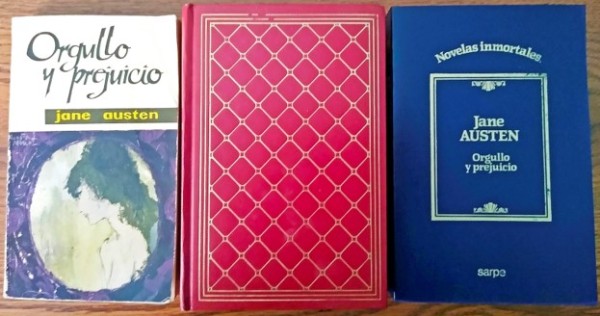
Editions with Villamuera’s translation
The design for the Arco Iris collection is simple and elegant, a white paperback cover in a frame of blue and gold. At the top, the author and title are also in gold; the collection name and its logo (a double rainbow) are at the bottom. At first sight the books look as if they were hardbound. The Riesco edition is red leatherbound but there is no other feature worth mentioning. The 1984 Sarpe edition is a blue paperback edition, no. 14 in its Novelas Inmortales collection; it includes an introduction and a bibliography. At the end of the century, Alba editorial reprinted Villamuera’s translation twice (1997 and 1999) without any translation credit and reproduced the introduction that appeared on the Sarpe edition (119–120, 362).
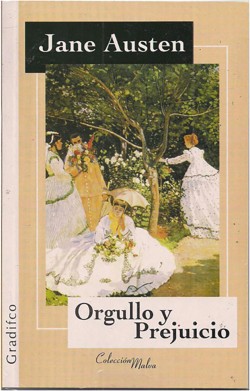
Cover of Gradifco edition in 2004
In 2004 in Buenos Aires, Gradifco published Orgullo y prejuicio in its Colección Malva [mallow/mauve]. Although the translation is credited to Juan Izquierdo, it matches Villanueva’s translation. Only the initial sentence is slightly modified in an attempt to disguise that it is a copy. In fact, a few details betray the plagiarism: 1) the introduction and bibliography from the Sarpe edition are reproduced; Elizabeth is referred to solely as Lizzy, never Elizabeth or Eliza; Georgiana’s name is translated as Jorgina.
Another fact that might have contributed, at least in Spain, to popularizing Orgullo y prejuicio in the mid-1960s was a ten-episode television adaptation of the novel, produced by TVE in 1966 for its series Novela, which Mari Carmen Romero has described quite extensively. The Novela adaptation is only one of the four Austen adaptations produced in Spain that has not been recovered by Radio y Televisión de España (RTVE) from its archives; it is probably completely lost.
Gilson mentions two new editions of the novel issued in 1970, one by Editora Interciencia, the other by Iter Ediciones. No translator is credited on the first, and I have not been able to find any copies, though there is an ISBN record for it, and, since it has 368 pages, it is safe to assume it is unabridged. Only by cross-checking the text could one ascertain if it was a new translation or the reprint of a previous one.
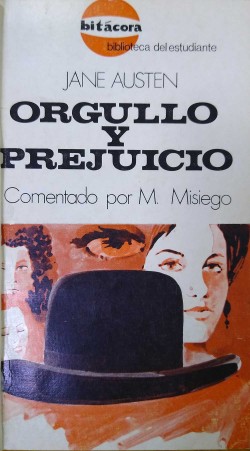
Iter edition
Orgullo y prejuicio issued by Iter was, at that time, the most scholarly edition of this novel, part of Iter’s Bitácora Biblioteca del Estudiante collection [Students’ Library Logbook]. Iter, which later turned into Narcea Ediciones, is a publishing house founded by schoolteachers and pedagogues. Micaela Misiego Llagostera (1925–2010) is credited for the introduction, footnotes, and commentaries, but there is no mention of the translator. In Jiménez Carra’s opinion, if Misiego was the translator she would have been credited as such (118). As we have seen, there are editions of Orgullo y prejuicio for which no translators were credited, and Jiménez Carra managed to identify the translator. Since Misiego was a college professor of English, a published author, and also a translator of English works, I believe it would be safe to assume she was also the translator for this edition of Orgullo y prejuicio. Her introduction to the novel is quite extensive (forty-seven pages), in which she provides biographical information, comments on Austen’s style, and an analysis of the novel; her forty-one footnotes give cultural information; the commentaries provide a close reading of three passages from the novel (the invitation to dance a reel, Collins’s marriage proposal, and Elizabeth’s revelation to Jane about Wickham’s true character). Unfortunately, the cover image selected for this edition presents female faces in the background and a bowler hat in the foreground—again an anachronism that maintains the mistaken notion of Austen and her works as Victorian. Gillian Dow, however, points out that the hat “is enough to signal to the Spanish reader that it is an English classic” (130).
The only new Pride and Prejudice translation published in the 1980s was released by Ediciones Cátedra in 1987. It would become a landmark as it is considered the only critical edition of this novel published in Spanish (the Iter edition is usually forgotten, even by Díaz Bild). Perhaps because of that, the translation has become the most rehashed ever since—almost any low-cost edition of the novel is most likely based on it, if not merely copied and credited to someone else.
At the time, Cátedra was a relatively young publishing house (having been established in 1973), specializing in critical annotated editions for high-school and university studies, mainly through its Letras Hispánicas collection, a black paperback collection of works originally written in Spanish. As a complement, in 1983, however, Cátedra started the Letras Universales collection (in white paperback as a contrast to the Hispánicas collection in black), where translations of world literature were offered. Orgullo y prejuicio entered that list as number 81 in 1987. The edition was prepared by José Luis Caramés Lage (1945–2019), with an extensive fifty-three-page introduction on Austen’s life, works, and style as well as a six-page bibliography. The translation is by María Antonia Ibáñez, her only credit as a translator. It is not stated whether the notes are the editor’s or the translator’s. Jiménez Carra believes that they might have been written by Ibáñez since they are mostly linguistic notes, but she notices that the explanation provided in a footnote on the special license is wrong (283–84), a mistake initiated by Irene Polo, as Barchas reports.
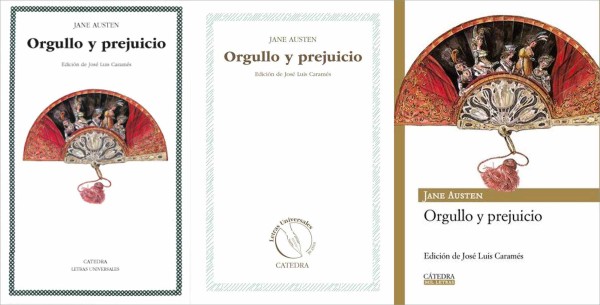
Cátedra editions
Unfortunately, the footnote is not the only flaw in the Ibáñez translation. She tends to make more explicit some sentences, omits others, creates contradictory meanings. Sometimes her translation choices are inaccurate. Although there is no perfect translation, a defective translation for the assumed most scholarly edition of the novel in Spanish does not bode well. On the positive side, all those mistakes help identify the many occasions when this translation has been misappropriated. For example, among the most noticeable are the omission of a sentence in the description of Mrs. Bennet in the very first chapter, a brief but important piece which helps us to understand such a character, and the incorrect report of Charlotte Lucas’s age as twenty, changing how readers comprehend her decisions.
Beside several reprints of the novel in its Letras Universales collection, in 2008, Cátedra has also included it in Mil Letras [Thousand Letters], a collection of its bestsellers to commemorate its thirty-fifth anniversary by reissuing one thousand different titles in its emblematic collections. As compared to the Letras Universales edition, the Mil Letras edition has a bigger font and a sturdier binding, imitating hardback; it also redesigned the fan that previous editions had used as cover image for Pride and Prejudice. (The thirtieth-anniversary Letras Universales edition dispensed with the fan, presenting a plain white cover.)
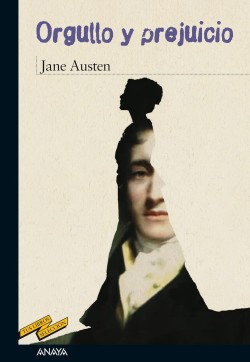
Anaya edition
Ibáñez’s translation has been also legally used in a 2013 edition by Editorial Anaya for its children and teenagers’ line (Anaya Infantil y Juvenil). Instead of Caramés’s introduction, it includes a brief introductory note by Ana Isabel Conejo on Jane Austen. She also wrote an appendix for the edition: “Una tarde de invierno” [“A Winter Afternoon”], a short Pride and Prejudice sequel. The footnote on the special license has been amended but is only partially correct. The printed edition also includes black-and-white illustrations by Enrique Flores, but they are not part of the e-book version available at online bookstores and apps. Both Cátedra and Anaya are part of the Anaya publishing group and belong to Hachette.
First published in 1987, Ibáñez’s translation is still under copyright. Unfortunately for Ibáñez, Grupo Anaya, and Hachette, her translation is the one that circulates quite freely, though illegally, online. Anyone can simply download this translation and use it. Therefore, as has been pointed out, it has been used for a never-ending stream of low-cost Orgullo y prejuicio editions: as a straight copy of the translation, without crediting the rightful translator or attributing it to someone else, or sometimes in disguise with alterations (i.e., replacing some words with synonyms, reorganizing syntax), which might make the text unintelligible, and by omitting the many footnotes originally included in the Cátedra edition. Such low-cost editions have been issued in many countries. To name a few:
- The 1997 Andrés Bello edition, translation attributed to A.L.A., which has been reprinted several times and is available on both sides of the Atlantic and as an e-book.
- The Terramar edition in Argentina in 2010, where the translator is not even credited.
- The 2012 Book Trade edition, which credits not only the prologue but the translation to Fracnesc LL. Cardona; however, the mistakes betray the copy.
- The bilingual edition Orgullo y prejuicio / Pride and Prejudice, published by Dualbooks in 2012, without translation credits.
- Since 2013, different Plutón Ediciones editions, with translation credited to Benjamin Briggent, with slight modifications to disguise the loan, but without amending the mistakes. A 2020 edition also included black-and-white illustrations by Katherine Silva.
- Also, with modifications to disguise it is a copy, the editions published by Ediciones Lea in Argentina since 2014; the prologue and the edition are credited to Luis Benítez, but there is no mention of translator. It is available as an e-book.
- The Mestas editions published since 2015.
- In 2022, the Trama Literaria edition, which Colofón has released in Mexico.
- All the Editores Mexicanos Unidos editions published since the 2010s in Mexico, which have been credited to Julián Moreno first, then to Gonzalo Lozada, and lately to Lorena Maythe Lojero Guevara. If Ibáñez’s mistakes in translation were not enough, Lojero made some changes that make the text even stranger. She transformed all the characters into sirs and ladies, so Mr. and Mrs. Bennet become Sir and Lady Bennet, but also their eldest daughter has been turned from Miss Bennet into Lady Bennet, which makes it even more confusing. Furthermore, the latter editions are not very low-cost, since they are hardbound.

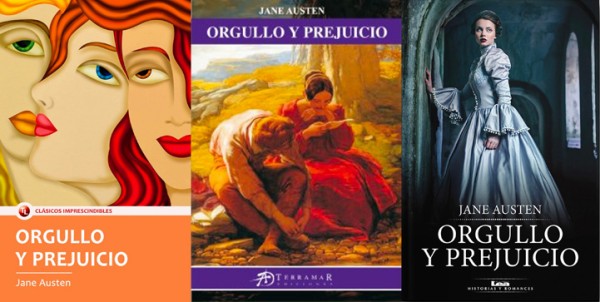
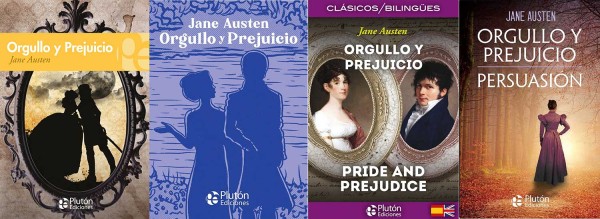
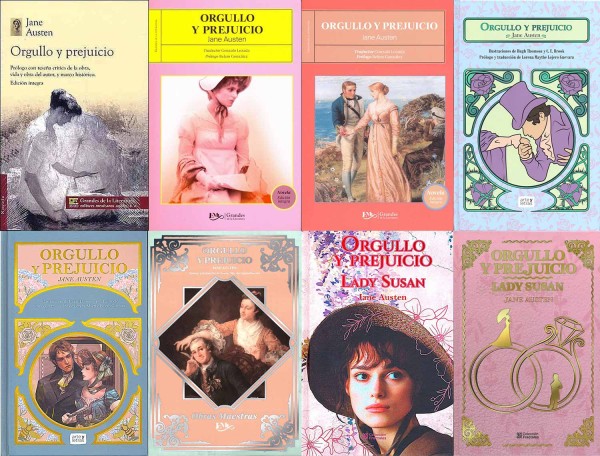
Different editions based on Ibáñez’s translation but credited to others
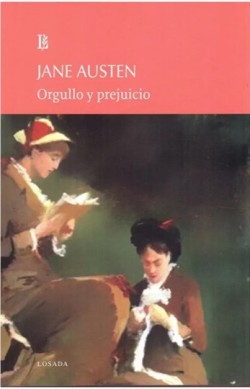
Losada edition
On the other end of the spectrum, it seems there is at least one edition based on Ibáñez’s translation amending many mistakes: the Orgullo y prejuicio edition published by Losada in 2009. Losada, one of the most prestigious Argentinian publishing houses, was established in 1938 after its founders broke with Espasa-Calpe because their political sympathies. Losada, the “publishing house of the exiled,” that is the Spanish intellectuals (like Irene Polo i Roig) who fled from their country due to Franco’s dictatorship, had a large catalogue specializing in authors writing in Spanish and carefully curated editions. Although it also published translations of works in other languages, they were mainly by twentieth-century writers, so Austen was not incorporated in its catalogue until this century as she has become more known to the Spanish-speaking public. In 2009 Losada issued Orgullo y prejuicio for its Grandes Clásicos [Great Classics] collection with prologue, footnotes, and translation credited to Delia Pasini.
Delia Pasini (1945–2018) was a poet and lauded translator. She had a long collaboration with Losada, for which she translated mainly poetry and drama—for example, Shakespeare, Dickinson, and Wilde. In fact, in 2003 she was awarded the Teatro del Mundo prize by the Universidad de Buenos Aires for her translation of the complete Oscar Wilde plays (Ingberg 377). In the Orgullo y prejuicio edition by Losada, the eight-page prologue ponders Austen’s life and works, quoting Marilyn Butler and George Steiner on Austen’s style. There are only four footnotes: on Cheapside, loo, the suffix shire, and white soup. The first repeats the mistaken notion that the name refers literally to a cheap London area (also present in Ibáñez’s translation), though the shire and white soup explanations are Pasini’s contributions. The translation resembles Ibáñez’s quite often, but with many amendments, which leads me to suspect Pasini might have used Ibáñez’s version as a working reference, cross-checked with Austen’s text in English at hand; she thus corrected several mistakes, including the infamous omission of the sentence at the end of the first chapter and stating correctly Charlotte’s age. It is an unusual way for a translator to work, but at least Pasini also used the original source, unlike many pseudo-translators who just misappropriated Ibáñez’s text. Pasini’s is indeed a revision and improvement.
![]()
The history of Pride and Prejudice in Spanish has stretched over a century, and, as attested by the numerous editions of the novel in that language, it has been the novel through which many readers become familiar with Austen. Its prominence is no surprise as it follows the pattern we see in other languages and countries. This first part of this novel’s journey through the Spanish language covers the first 70 years, before the age of Internet and the big boom of screen adaptations.
It is a period where Pride and Prejudice faced a slow but steady rise to popularity, under the influence of the 1940 motion picture and a political context in Spain that determined other publishing trends. For example, these factors helped determine Austen’s characterization as a writer of romance literature for women and the use of anachronistic covers depicting a Victorian world, instead of the Georgian era and the Regency. Fortunately, also as time went by, Austen’s literary status became more acknowledged as this novel was included in collections of world literary classics. As some translations attest, however, often neither translators nor readers knew much about Austen’s world. Though the number of editions of Orgullo y prejuicio in Spanish might seem even in this early period countless, on examining the text one can discover the number of separate translations is much smaller. These translations are still printed and rehashed well into this first quarter of the twenty-first century, either crediting the real translator or attributing the text to another, barely disguising the duplication by replacing vocabulary with synonyms or changing syntax but without examining what Austen really wrote in English or amending mistakes. This shady practice seems to be common, even acknowledged in the publishing industry in Spanish, even among some powerful and prestigious publishing houses, to keep costs low, though it undermines quality.
Also obvious is Spain’s predominance in the Spanish-language publishing world. Spain’s Civil War might have disrupted this industry for a while, prompting the release of a few Latin-American editions of Pride and Prejudice in Spanish, but still the translators were mainly Spaniards working in their country or in exile. Such a situation leads to another consequence: translations with vocabulary and turns of phrase more familiar to Spaniards, but not commonly used or understood by Spanish-speaking readers on this side of the Atlantic.
No less important, during this period only three illustrated editions of the novel were initially published in Spanish. For later editions new illustrations have been commissioned to offset recycled and rehashed translations. The only two scholarly editions so far were initially released in these years. Of the three initially illustrated editions, only two sets of the illustrations were period accurate. Of the scholarly editions, one was issued only once and remains out of print, while the other is still reprinted—the most pirated, despite being a defective translation.
Have things changed for Pride and Prejudice in Spanish once the golden age of adaptations dawned all over the world? That will be examined in the second part of this research.
ACKNOWLEDGEMENTS
I would like to express my profound gratitude to Susan Allen Ford, Carol Moss, and my anonymous reviewer for all their work in revising and editing this and the other essays that are part of this research on the history of Pride and Prejudice in Spanish.
NOTES
1 People have the mistaken notion that Jane Austen’s works are in the public domain; however, that is true only of the English text. For Pride and Prejudice translated into other languages, the copyright belongs to the translators, so copyright is dependent on the date of publication, the translator’s date of death, and how long the country of publication protects copyright.
2The war, of course, explains the hiatus; there are also Argentinian editions that Jiménez Carra and Díaz Bild do not consider.
3David Gilson lists it as a separate translation.
4Gilson and Jiménez Carra list this Berenguer translation as the second time the novel was published in Spanish. As we have seen, however, because they do not consider the two 1940 Argentinian editions reported above, it was, in fact, the fourth time the novel was published.
5The text begins to match Berenguer’s translation at the point when Mrs. Bennet says, “‘When a woman has five grown up daughters, she ought to give over thinking of her own beauty.’”
